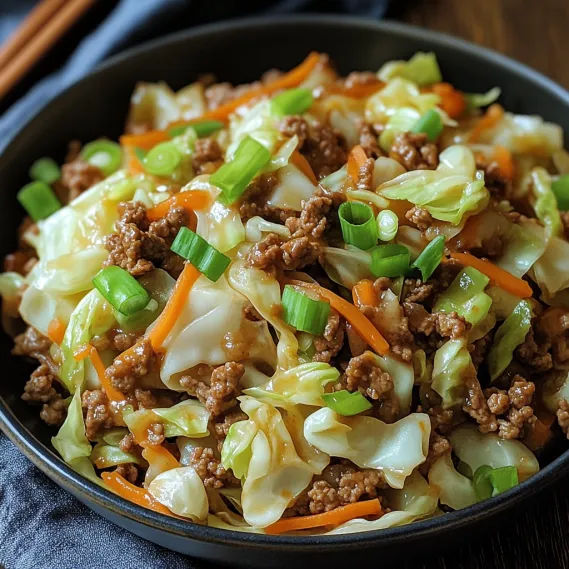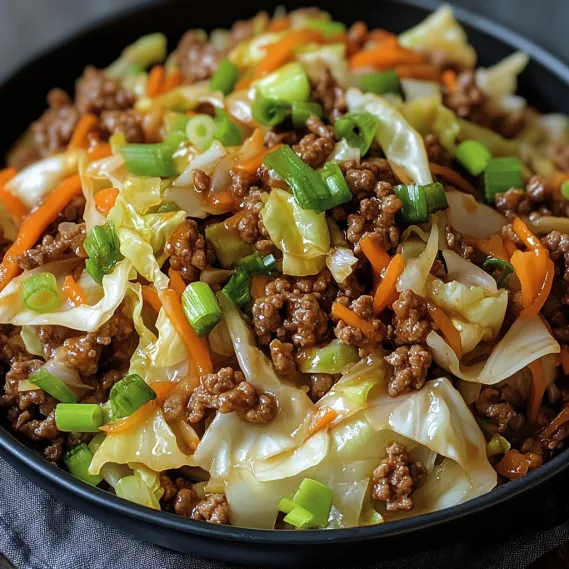 Pin
Pin
This hearty Chinese Ground Beef Cabbage stir-fry has been my weeknight dinner salvation for years. The combination of savory beef with crisp vegetables creates a perfect balance that satisfies the whole family while keeping dinner healthy and flavorful.
This recipe became my go-to during busy weeknights when I needed something nutritious that my children would actually eat. The first time I made it, my picky eater asked for seconds, and it has been in regular rotation ever since.
Ingredients
- Lean ground beef: Gives this dish satisfying protein while keeping it relatively light. Look for 90% lean for best flavor without excess fat.
- Green cabbage: Adds volume, crunch, and nutrition. Choose firm heads with tightly packed leaves for maximum freshness.
- Carrots: Provide natural sweetness and beautiful color contrast. Select firm, bright orange carrots for best flavor.
- Sesame oil: Brings authentic Asian flavor that regular oils simply cannot replicate. A little goes a long way.
- Fresh ginger and garlic: Create the aromatic foundation. Always use fresh rather than powdered for authentic flavor.
- Low sodium soy sauce: Allows you to control the salt level while adding umami depth.
- Oyster sauce: Adds complex savory flavor that ties everything together. Look for premium brands for best taste.
- Rice vinegar: Balances the savory elements with subtle acidity. Do not substitute with stronger vinegars.
- Cornstarch: Creates the silky sauce texture that coats every ingredient perfectly.
How To Make Healthy Chinese Ground Beef Cabbage
- Heat the Wok:
- Begin by heating your wok or large skillet until it's very hot before adding the sesame oil. The oil should shimmer but not smoke. This high heat is crucial for authentic stir fry flavor and prevents the vegetables from becoming soggy.
- Brown the Beef:
- Add your ground beef to the hot oil and break it into small pieces with your spatula. Let it cook undisturbed for about 2 minutes before stirring to develop better browning. Continue cooking until no pink remains, about 5 minutes total. The caramelization adds tremendous flavor to the final dish.
- Incorporate Aromatics:
- Add the minced garlic and grated ginger directly to the cooked beef. Stir constantly to prevent burning. The heat from the beef and pan will release their essential oils and fragrances. You should immediately smell the wonderful aroma that forms the backbone of Chinese cooking.
- Add Vegetables:
- Introduce the sliced cabbage and julienned carrots to the pan. Maintain high heat and stir frequently. The goal is to soften the vegetables slightly while maintaining some crispness. This contrast in textures makes the dish especially satisfying. The cabbage will reduce in volume significantly as it cooks.
- Create the Sauce:
- Pour the soy sauce, rice vinegar, and oyster sauce directly onto the beef and vegetable mixture. Stir thoroughly to ensure every piece gets coated. These ingredients work together to create the complex flavor profile that makes this dish so delicious.
- Thicken and Finish:
- Add the cornstarch slurry while the pan is still hot. Stir continuously as the sauce thickens, which happens quickly. The cornstarch creates that restaurant-quality glossy sauce that clings beautifully to each bite. Make sure no lumps remain.

The oyster sauce is my secret ingredient in this recipe. When I first started cooking Chinese food at home, I was amazed at how this single ingredient transformed my cooking from good to restaurant quality. My husband always knows when I have used it because he immediately comments on how authentic the dish tastes.
Meal Prep Magic
This beef and cabbage stir fry is perfect for meal planning. The flavors actually intensify overnight as the ingredients meld together. Simply prepare a double batch, portion into microwave-safe containers, and refrigerate for up to 4 days. For best results when reheating, add a teaspoon of water before microwaving to restore moisture, and stir halfway through heating.
Ingredient Substitutions
Ground beef can be swapped for ground turkey, chicken, or even plant-based meat alternatives. If using poultry, add an extra tablespoon of oil to prevent dryness. Savory mushrooms like shiitake make an excellent vegetarian alternative when finely chopped and cooked until their moisture evaporates.
The cabbage variety can be changed according to preference. Napa cabbage offers a more delicate texture, while purple cabbage provides stunning color contrast. For added nutritional boost, include bok choy or thinly sliced kale in the vegetable mix.
If oyster sauce is unavailable or you need a vegetarian version, hoisin sauce makes a reasonable substitute, though the flavor profile will be slightly sweeter. For a gluten-free option, use tamari instead of soy sauce and check that your oyster sauce is gluten-free certified.
Serving Suggestions
While delicious on its own, this stir fry becomes a complete meal when served over steamed jasmine rice. For a lower-carb alternative, cauliflower rice works beautifully. The neutral base allows the flavorful sauce to shine.
For added texture, sprinkle toasted sesame seeds or crushed peanuts on top just before serving. A side of quick-pickled cucumbers provides a refreshing contrast to the rich, savory main dish.
If serving guests, consider offering small bowls of additional condiments like chili oil, sriracha, or extra soy sauce so everyone can customize their plate to their preferred spice level.

Cultural Context
This recipe represents a simplified home-style Chinese cooking approach that has been adapted for Western kitchens. In traditional Chinese cuisine, cabbage dishes often symbolize prosperity due to the vegetable's abundance and affordability. Ground meat with cabbage variations can be found throughout regional Chinese cooking, particularly in northern provinces where heartier dishes are favored during cold weather.
The combination of fresh ginger, garlic, and green onions creates what Chinese cooks call the "trinity" of aromatics, forming the foundation of countless dishes. The quick cooking method preserves nutrients and highlights the natural flavors of each ingredient, embodying the balance that Chinese cuisine strives for.
Recipe FAQs
- → Can I use a different type of ground meat?
Yes, you can substitute ground beef with ground chicken, turkey, or pork. Adjust the seasonings slightly to match your choice of meat for the best flavor.
- → What can I use instead of oyster sauce?
If you don't have oyster sauce, you can use hoisin sauce or a mix of soy sauce with a touch of sugar for a similar flavor profile.
- → How do I make this dish gluten-free?
To make this dish gluten-free, consider using tamari or coconut aminos in place of soy sauce and ensure your oyster sauce is labeled gluten-free.
- → Can I prepare this in advance?
Yes, you can prepare the stir-fry in advance, but for the best texture, it's recommended to cook the vegetables just before serving to retain their crunch.
- → What vegetables can I add or substitute?
You can add or replace the cabbage and carrots with bell peppers, broccoli, snap peas, or bok choy to suit your taste or use up what you have on hand.
- → What’s the best rice to serve with this dish?
Steamed jasmine rice or brown rice pairs well with this dish. You can also serve it with cauliflower rice for a lower-carb option.
